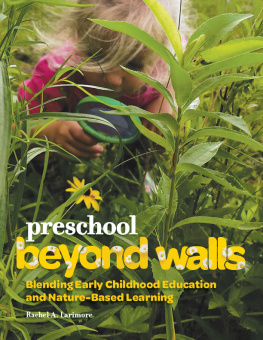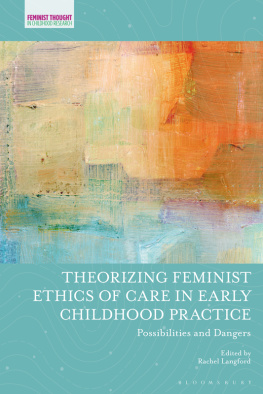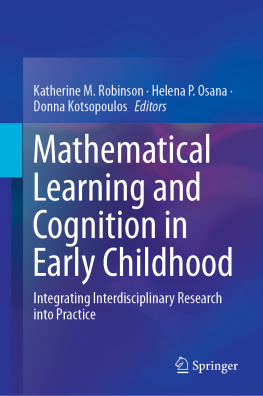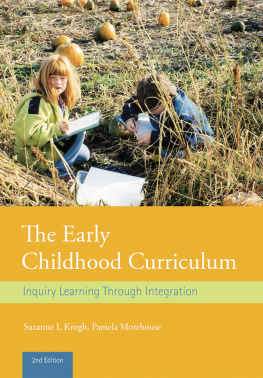
Published by Redleaf Press
10 Yorkton Court
St. Paul, MN 55117
www.redleafpress.org
2015 by Carol Garhart Mooney
All rights reserved. Unless otherwise noted on a specific page, no portion of this publication may be reproduced or transmitted in any form or by any means, electronic or mechanical, including photocopying, recording, or capturing on any information storage and retrieval system, without permission in writing from the publisher, except by a reviewer, who may quote brief passages in a critical article or review to be printed in a magazine or newspaper, or electronically transmitted on radio, television, or the Internet.
First edition 2015
Cover design by Jim Handrigan
Cover illustration by Ian Handrigan, age 4
Interior design by Douglas Schmitz
Typeset in Kandal
Library of Congress Cataloging-in-Publication Data
Mooney, Carol Garhart.
Theories of practice : raising the standards of early childhood education / Carol Garhart Mooney.
pages cm
Summary: With stories, anecdotes, and a discussion about the strong connection between theory and best practices, this guide will help you understand the value of applying your knowledge of educational theory to your work as you refine your practices, create thoughtful curriculum, and do your best to raise the standards of early childhood educationProvided by publisher.
Includes bibliographical references and index.
ISBN 978-1-60554-297-3 (e-book)
1. Early childhood education--Philosophy. 2. Early childhood educationCurricula. I. Title.
LB1139.23.M65 2014
372.21dc23
2014025122
To Marc, for everything
Contents


IN THIS BOOK, ONCE AGAIN, Carol Garhart Mooney shares with us her rich insights based on extensive experience of working in the complex and challenging provisions for the care and education of young children. Throughout her analyses and discussions of the day-to-day challenges and complexities involved in early childhood education, she helps us to grasp the important contribution of how we understand the nature of our workits responsibilities and the potential consequences of our theories (some conscious and others not necessarily so) of how our practices work.
Mooney also examines what she refers to as a disconnect between the important theories of development and learning, and how our daily practices often fail to apply the vast and growing amount of relevant knowledge now available. Her discussions carry a strong emphasis on the importance of the theoretical bases of our work. As she puts it: More than ever, people working with young children and their families need education and understanding of child growth and development (17). She strongly supports the view that an important attribute of a teacher is that she or he is also a learner... a constant learnernot only from firsthand experience, but also from the growing body of related information and knowledge in the field.
In addition to her very useful references to the theories and the expanding knowledge base related to early childhood education and child rearing in the early years, Mooney presents a clear and convincing position of the importance of improving early childhood education as a profession.
Mooneys main theme puts the value of theory and related hypothesesbased on reasoningin the practical context of the daily challenges faced by practitioners in the field. Her suggestion that no one theory is universally accepted as the theory of how and why children grow and learn as they do (28) is followed by the very useful suggestion that practitioners at every level of responsibility and at various levels of qualifications are likely to gain greatly from constant interactions and reflections with their colleagues.
While the title of this work seems to emphasize theory, Mooney makes it clear that practice refers directly to the ways we respond (or fail to respond) to the children who are with us. She makes the point that surely all practices are based on theories and related hypothesesbut not necessarily appropriate ones. It is most likely that the majority of practitioners in the field of early education and care are unaware of the theoretical bases of many of their actions.
Every page raises and explores many of the frequent practical challenges practitioners face day-to-day. Reading Mooneys exploration of the implications of various theories of practice is enlightening as well as provocative and enriches the growing profession of early childhood education.
Lilian G. Katz, PhD
University of Illinois

FOR SUCH A TINY BOOK, the list of those involved is lengthy. My first thanks go to my husband, Marc, for reading, editing, IT assistance, suggestions, and final preparation, and my son, Brian Mooney, for always playing devils advocate! Kyra Ostendorf and David Heath at Redleaf Press consistently offer answers, encouragement, and humor that keep the books coming.
This book involved continual input from direct service practitioners. High on that list are Marilyn Nicholson, Yvette Robert, Marjiana Kljajic, Kathy Trellis, and Erin Mooney. In addition, a faithful group of focus group attendees kept showing up at the end of long workdays to discuss their work with children and families. Their knowledge is extensive, their experience vast, and their commitment to early childhood education an inspiration. You know who you are. I offer my heartfelt thanks.
Thank you to the professional picnic group that, for more than three decades, has supported me and any work I get accomplished. Thanks especially to Sara, Tessa, Cindy, Karen, Wendy, and Susan.
Special thanks to Cindy Wallace, Tracy Pond, Claudette Mallory, and many others at New Hampshire Child Care Resource and Referral for lending support, arranging focus groups, and gathering feedback from the field every time I write.
Behind the scenes much of the time but front and center when I need information and encouragement are the people at the Child Development Bureau: Dr. Ellen Wheatley, Kristin Booth, Sue Foley, and Jessica Locke. Thanks for all you do.
In small and large ways, folks at Early Learning NH and Spark NH put information in my hands and critical phone numbers on my cell phone as well as all around ECE support. These include Laura Milliken, Jackie Cowell, Katie Brissette, Brenda LaFratta, Carol Michael, Neal Scott, and especially Mary Jane Wallner, whose experience and friendship span the decades.
Pat Meattey at Strafford County Head Start has put her mark on every book Ive ever written. Her expertise and sharing regarding the 2007 mandate for Head Start teachers gave me last-minute confidence about the importance of early childhood specific education and its daily impact, or not, on Americas children.
Next page







